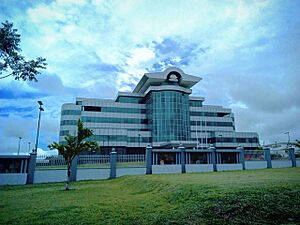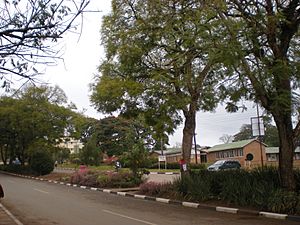Mzuzu facts for kids
Quick facts for kids
Mzuzu
|
|
|---|---|
| Country | |
| Region | Northern Region |
| Population
(2018 Census)
|
|
| • Total | 221,272 |
| Time zone | +2 |
| Climate | Cwb |
Mzuzu is a major city in Malawi, a country in southeastern Africa. It is the capital of Malawi's Northern Region. Mzuzu is the third largest city in Malawi based on its population.
In 2018, about 221,272 people lived in Mzuzu. Many students from Mzuzu University also come into the city each day. The city is located in the Mzimba District. Mzuzu sits in a valley within the Viphya Mountains. The land around the city is great for farming. Farmers here grow crops like tea, rubber, and coffee.
South of Mzuzu, you'll find the Viphya Plantation. This is the largest man-made forest in all of Africa. East of the city are the Lunyangwa and Kaning'ina forest preserves. These areas help protect nature.
Some well-known neighborhoods in Mzuzu include Chibavi, Luwinga, Area 1B, Chibanja, Katoto, Zolozolo, Masasa, Mchenga-utuba, Chimaliro, Kaning'ina, and Katawa.
Contents
History of Mzuzu
How Mzuzu Got Its Name
The name 'Mzuzu' came from a mistake in how early white settlers said the word 'Vizuzu'. 'Vizuzu' are plants that grow along the Lunyangwa River. These plants were seen near where the city is today. This area was also where people who grew tung oil settled.
The city of Mzuzu started to grow around a large tung oil farm in 1947. This farm was run by the Commonwealth Development Corporation. Mzuzu officially became a city in 1985.
People and Culture in Mzuzu
Who Lives in Mzuzu?
| Historical population | ||
|---|---|---|
| Year | Pop. | ±% p.a. |
| 1977 | 16,108 | — |
| 1987 | 51,904 | +12.41% |
| 1998 | 86,980 | +4.81% |
| 2008 | 133,968 | +4.41% |
| 2018 | 221,272 | +5.15% |
| source: | ||
| Ethnic Groups in Mzuzu City (2018 Census) | ||||
|---|---|---|---|---|
| Ethnic Groups | percent | |||
| Tumbuka | 51.71% | |||
| Chewa | 13.51% | |||
| Ngoni | 8.09% | |||
| Tonga | 7.36% | |||
| Nkhonde | 4.08% | |||
| Lambya | 3.75% | |||
| Yao | 3.59% | |||
| Lomwe | 3.54% | |||
| Sukwa | 1.07% | |||
| Sena | 0.66% | |||
| Mang'anja | 0.38% | |||
| Nyanja | 0.28% | |||
| Other | 2% | |||
The 2018 census showed that the Tumbuka people are the largest group in Mzuzu. They make up over half of the city's population, at 51.71%. The next largest group is the Chewa, who are 13.51% of the population.
Other groups living in Mzuzu include the Ngoni (8.09%), Tonga (7.36%), and Nkhonde (4.08%). Smaller groups like the Lambya, Yao, and Lomwe also live there.
Religions in Mzuzu
Religions in Mzuzu City (2018 Census) Church of Central Africa Presbyterian (28.01%) Catholic (17.28%) Seventh-day Adventist/Baptist/Apostolic (16.27%) Pentecostal (6.62%) Anglican (1.58%) Other Christian (22.21%) Muslim (4.06%) Traditional (0.1%) Other (3.59%) No Religion (0.28%)
The biggest religion in Mzuzu is the Church of Central Africa Presbyterian, with 28.01% of people following it. Catholicism is the next largest religion, at 17.28%.
Other Christian groups like Seventh-day Adventist, Baptist, and Apostolic make up 16.27% combined. Pentecostal (6.62%) and Anglican (1.58%) faiths are also present. About 22.21% of people follow other Christian churches. Islam is followed by 4.06% of the population. A small number of people follow Traditional beliefs (0.1%) or other religions (3.59%). Only 0.28% of people reported having no religion.
Languages and Traditions
The culture in Mzuzu is a mix of different traditions from Malawi's northern region. The Tumbuka language is spoken most often in Mzuzu. However, people also speak other languages like Chewa, Tonga, Swahili, and Ngonde.
Mzuzu has a museum that opened in 1986. It shows off old items and art from different cultures in the northern part of Malawi.
Popular Foods in Mzuzu
Some popular foods in Mzuzu include sima. This is a thick porridge made from either maize (called sima ya ngoma) or cassava (called sima ya mayagho). Rice, known locally as mpunga, is also a common food.
Another favorite is batala fish, which is a type of fish called a bottle-nosed mormyrid. This fish comes from the nearby Lake Malawi in Nkhata Bay. People also commonly eat maize, bananas, plantains, cocoa, cassava, and sweet potatoes.
Climate and Environment
Mzuzu's Weather
| Climate data for Mzuzu (1961–1990) | |||||||||||||
|---|---|---|---|---|---|---|---|---|---|---|---|---|---|
| Month | Jan | Feb | Mar | Apr | May | Jun | Jul | Aug | Sep | Oct | Nov | Dec | Year |
| Mean daily maximum °C (°F) | 25.5 (77.9) |
25.6 (78.1) |
24.8 (76.6) |
23.5 (74.3) |
22.1 (71.8) |
20.4 (68.7) |
20.3 (68.5) |
21.9 (71.4) |
25.1 (77.2) |
27.2 (81.0) |
27.2 (81.0) |
26.1 (79.0) |
24.1 (75.4) |
| Daily mean °C (°F) | 19.9 (67.8) |
20.0 (68.0) |
19.5 (67.1) |
18.7 (65.7) |
16.4 (61.5) |
13.9 (57.0) |
13.1 (55.6) |
14.0 (57.2) |
16.7 (62.1) |
19.4 (66.9) |
20.5 (68.9) |
20.1 (68.2) |
17.7 (63.9) |
| Mean daily minimum °C (°F) | 16.1 (61.0) |
16.5 (61.7) |
16.0 (60.8) |
14.9 (58.8) |
11.6 (52.9) |
7.9 (46.2) |
6.5 (43.7) |
6.6 (43.9) |
8.7 (47.7) |
11.7 (53.1) |
14.2 (57.6) |
15.9 (60.6) |
12.2 (54.0) |
| Average precipitation mm (inches) | 203.3 (8.00) |
179.5 (7.07) |
224.1 (8.82) |
213.0 (8.39) |
58.8 (2.31) |
29.5 (1.16) |
30.1 (1.19) |
11.8 (0.46) |
10.4 (0.41) |
35.4 (1.39) |
95.7 (3.77) |
197.0 (7.76) |
1,288.6 (50.73) |
| Average precipitation days (≥ 0.3 mm) | 20 | 18 | 20 | 19 | 9 | 6 | 6 | 3 | 2 | 3 | 9 | 18 | 133 |
| Average relative humidity (%) | 82 | 82 | 85 | 86 | 85 | 84 | 83 | 77 | 67 | 62 | 70 | 80 | 79 |
| Mean monthly sunshine hours | 145.7 | 137.2 | 164.3 | 171.0 | 217.0 | 219.0 | 238.7 | 275.9 | 288.0 | 300.7 | 252.0 | 176.7 | 2,586.2 |
| Mean daily sunshine hours | 4.7 | 4.9 | 5.3 | 5.7 | 7.0 | 7.3 | 7.7 | 8.9 | 9.6 | 9.7 | 8.4 | 5.7 | 7.1 |
| Source: NOAA | |||||||||||||
Mzuzu is located in a beautiful area with many trees and hills. The main type of forest around the city is called Miombo woodland. This forest has many different kinds of trees.
North and south of Mzuzu, the Viphya Mountains have special grasslands and forests that grow in cooler, higher places. The Viphya Plantation, south of the city, is known as the largest man-made forest in Africa. During the cold season, the weather in Mzuzu can be quite chilly.
Farming in the Region
The area around Mzuzu is very important for farming. Farmers here focus on growing tea, rubber, and coffee. These crops are a big part of the local economy.
Economy and Infrastructure
How Mzuzu Makes Money
Mzuzu is a busy place for business in the region. It is a center for producing coffee, timber (wood), fruit, milk, and honey. The city also has factories that make medicines, beauty products, and timber goods.
Thanks to Mzuzu University, the city has many skilled workers. Mzuzu has good land for farming, but it is still working on getting enough reliable electricity. Small businesses in the city offer services like phone connections, internet cafes, and general stores. You can also find national store chains like Chipiku and Peoples Trading here.
Mzuzu is home to national companies such as Mzuzu Coffee, Kentam Products Limited, Mzupaso Paints Limited, and Northern Life magazine. The city has two main markets. One of them is Taifa Market, where you can buy fruits, clothes, cellphones, shoes, and many other items.
Education in Mzuzu
Universities and Colleges
Mzuzu is home to Mzuzu University, which was started in 1999. This university has five main areas of study:
- Tourism and Hospitality Management
- Education
- Health Sciences
- Environmental Sciences
- Information and Library Science
Mzuzu Technical College is also located here. It was founded in 1958 and teaches students practical skills.
High Schools and Primary Schools
The city has some of the best high schools in the northern region. These include Marymount Secondary School, Wukani Private Secondary School, Katoto Government Secondary School, Zolozolo Community Day Secondary School, Viphya Schools, and Mzuzu Academy.
There are also several primary schools for younger students. Some of these are Wukani, Trust Academy, Wongani Private Primary School, Beehive, and Hilltop schools.
Fun Things to Do in Mzuzu
Tourist Spots and Entertainment
Mzuzu is close to some amazing places for tourists. Lake Malawi is a beautiful lake nearby. Nyika National Park, which is Malawi's largest park, is also a great place to visit.
For entertainment, you can go to the Mzuzu hotel or O Seasons. Other fun spots include the Mzuzu Golf Club, Villa Kagwentha (which has discos on Saturday nights), and the Squirrels Park. There are also places to relax like Lake View Lodge and the Mzuzu Sanctuary.
The Mzuzu Botanic Gardens are located in the Zolozolo area. If you like hiking, you can explore the nearby Kaning'ina mountains. Gulliver Dam, which provides water to Mzuzu, also offers hiking trails.
The 1st Poulner Scout Group from the UK has a Scout Campsite just outside Mzuzu called the Kavuzi Campsite.
Transportation in Mzuzu
Getting Around the City
Mzuzu City has its own airport, the Mzuzu Airport. In 2015, the Malawi Ministry of Public Works and Transport announced plans to build a new airport. However, as of 2022, construction had not yet started.
Mzuzu is located on Malawi's M1 highway. This important road runs all the way from the north to the south of the country. Mzuzu is also where the M5 highway begins. The M5 highway goes east through the Viphya Mountains towards Nkhata Bay, and then travels south along the shore of Lake Malawi.
Sports in Mzuzu
Football is a very popular sport in Mzuzu. The city has two main football teams that play in Malawi's top league: Moyale Barracks FC and Mzuni.
The city's only stadium is Mzuzu Stadium. It can hold up to 15,000 people and was built around 1970. Mzuzu also has two major basketball teams, Nkhulande and the Pistons.
Images for kids
See also
 In Spanish: Mzuzu para niños
In Spanish: Mzuzu para niños





